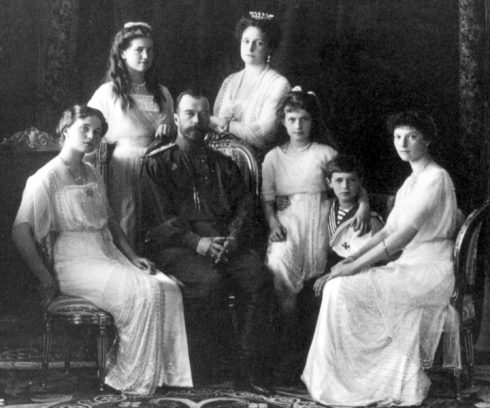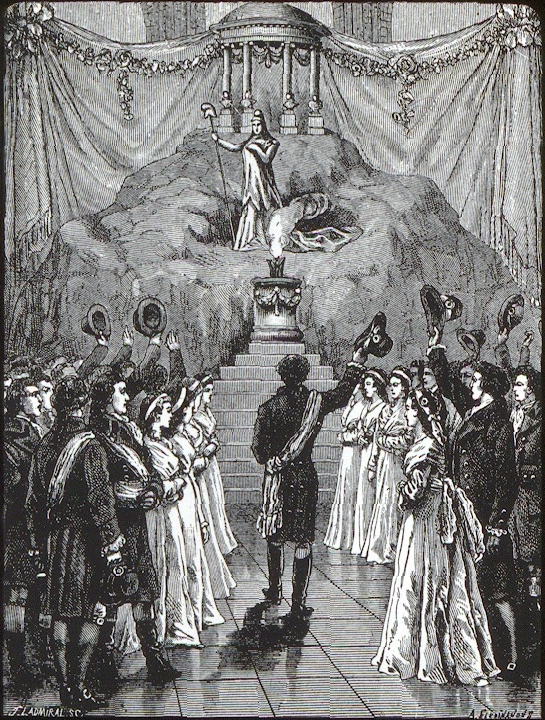By Prof. Plinio Corrêa de Oliveira
The periods in which the egalitarian Revolution* progresses the most are not periods of war and revolutions, but of small transformations. Wars and revolutions give it a tumble, but this provokes reactions and crystallizations, which sometimes bring difficulties.
What we should show is that the egalitarian Revolution does not consist of bloodshed. Bloodshed is a kind of accident in the egalitarian Revolution. Normally, it works like tuberculosis, which gradually corrodes the lungs. Therefore, there are alternating periods of violence and calm.

Tsar Nicholas II of Russia with the family (left to right): Olga, Maria, Tsarina Alexandra Fyodorovna, Anastasia, Alexei, and Tatiana. Photo taken in 1913.
Everyone remembers the law of the carrot and stick. From time to time the social body is somewhat recalcitrant to revolutionary ideas. The Revolution then prepares a beating, after which the “sensible” people say, “We cannot return to the old system, so let us make concessions and continue go on living.” However, these beatings are colossal.
This is important, for when we speak of egalitarian Revolution, many people will think of the Tsar, the Tsarina, the Grand Duchesses who were massacred. We have to get this out of their heads, for also small and gradual transformations of ideas, life and values end up making the egalitarian Revolution.

Separation of Church and State sign at the LGTBQ Stonewall Protest in New York. Photo by Jeffrey Bary.
The Egalitarian Revolution is a Religious Revolution
Let me distinguish a few things that should be clearly separate in our parlance. In the movement of the egalitarian Revolution, we must distinguish:
1) The egalitarian Revolution;
2) The egalitarian character of the Revolution;
3) The metaphysical character of the Revolution;
4) Its domestic character;
5) The Revolution’s doctrinal character and intolerance.
These are the elements which I focus upon for a good demonstration of the above-mentioned principle.
The Egalitarian Revolution is the Contrary of the Reign of Jesus Christ
What do we understand about the egalitarian ideal? It is the reign of equality in souls and in society. I did not have time to look for a definition of the Reign of Jesus Christ in the writings of some good author, but normally, the concept is that it is the reign of Christ or Our Lady in the souls of men and in their relationships, that is, in human society. The egalitarian ideal is to establish the reign of equality, replacing Our Lord Jesus Christ with the metaphysical principle of equality.
How should one distinguish this egalitarian ideal? There is a distinction between egalitarian ideal and egalitarian Revolution. The ideal is the objective which they pursue. The Revolution is the action they carry out to achieve that ideal.
What is a “Revolution”?
One asks whether this Revolution deserves the name of Revolution. The word “revolution,” understood only as violent, bloody action, is habitually abused. Yet, in general, the egalitarian Revolution is not bloody. It is a Revolution because it seeks the inversion of values and of order. This is the sense in which it is a Revolution. For example, for a son to act inside the home to impose himself on his father and submit him to his authority is a revolutionary action because it subverts values even if done without a whimper or without shedding a drop of blood. It is a revolutionary movement because it upends values.
If the Revolution were an armed movement seeking to overthrow some government, then a counter movement by a legitimate king to fight a usurping tyrant would be a Revolution, and that king would be called a revolutionary leader. Yet, although his would be a violent action, it would not be a revolution.
The egalitarian ideal can be seen in so far as it is metaphysical. What is a metaphysical value? A metaphysical value is that which man seeks beyond the physical order and is placed as an absolute value above all others.
The Mystical Character of the Egalitarian Ideal
Egalitarianism is an ideal they love with religious fervor. Take, for example, a scholar who arrived at the conclusion that equality is good, but who took a cold or indifferent attitude toward it. We cannot call this a religious attitude. However, there is an egalitarian mysticism that is fiery, a kind of egalitarian religion which leads man to love equality with the burning passions of pride and arrogance. This gives rise to a positively religious, mystical attitude.
The Egalitarian Ideal as Doctrine
In addition to this metaphysics, to this egalitarian mysticism, there are truly doctrinal ramifications (mysticism is tendential) that favor equality. For example, the French Revolution’s Declaration on the Rights of Man. It is part of revolutionary sophistry. . . .
Egalitarian Intolerance
Egalitarianism is mysticism, and hence it has the intolerance inherent to all mysticism. This intolerance is one of the elements that prove the religious character of egalitarianism, for everything that is seriously religious is intolerant. It is intolerant according to its own logic, it gives rise to two types of persecution proper to intolerance, which the Romans called relegatio*, and the arenas.
We know what the arenas are nowadays: to give a person terrific beatings, send him to a concentration camp, give some medicine to make him crazy, etc.
*Relegatio was the exile with which the Romans punished those hostile to paganism.









